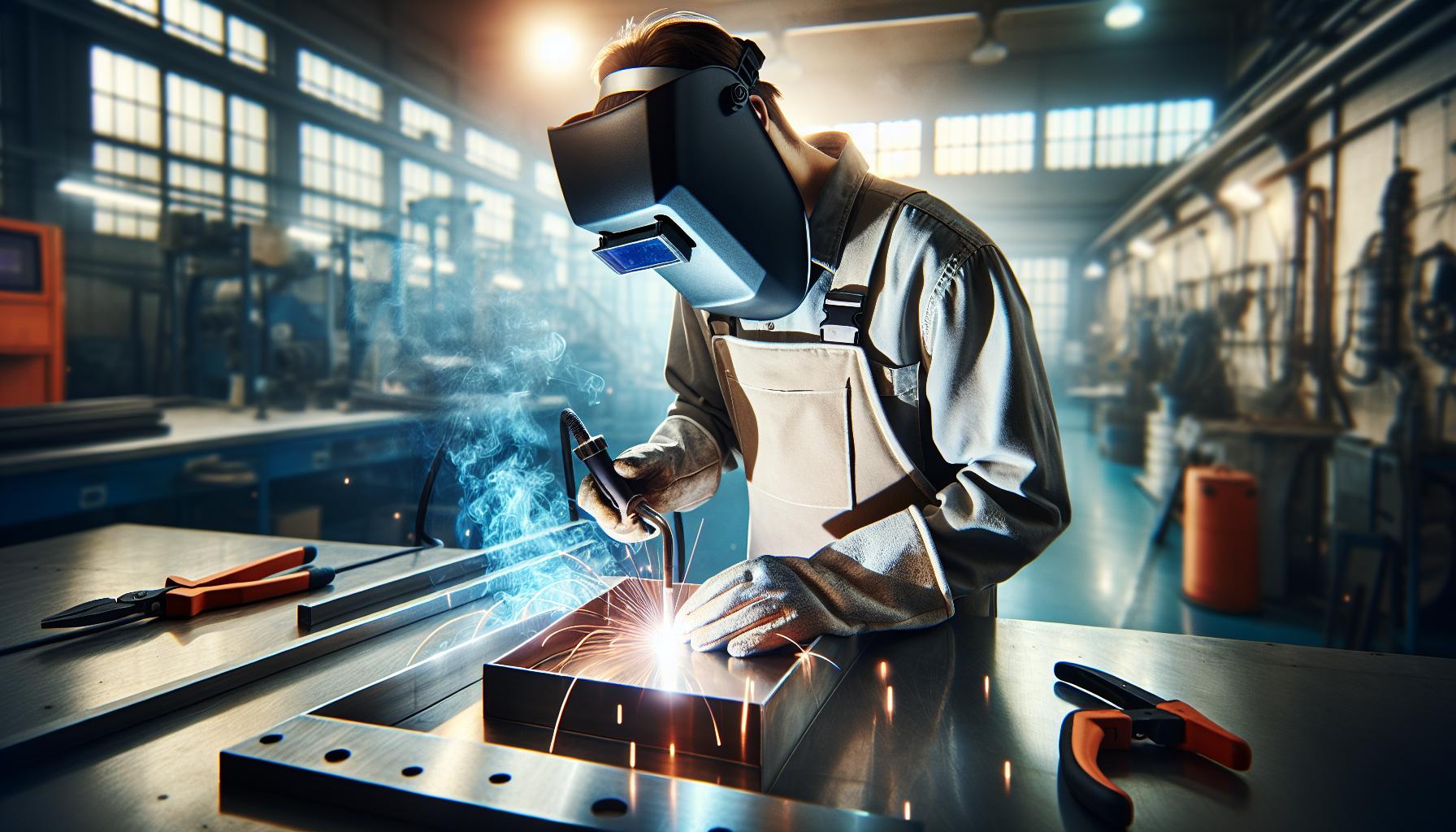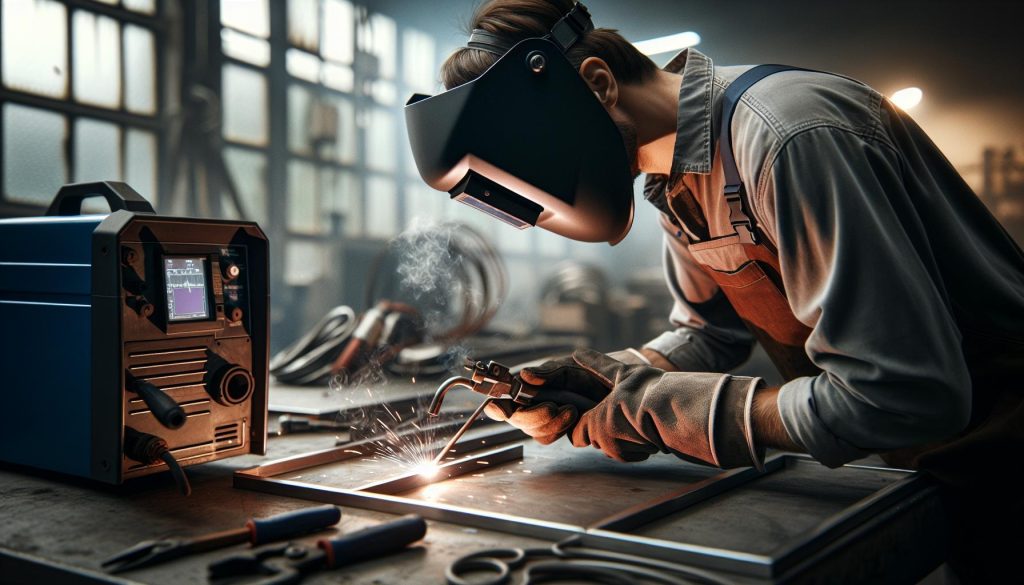Welding stainless steel can be a game-changer for both hobbyists and professionals, as it offers exceptional strength and corrosion resistance. However, many often wonder, “Can I effectively use a MIG welder for this task?” The answer is a resounding yes, but there are key considerations to keep in mind. The versatility of MIG welding makes it one of the most popular methods for joining various metals, including stainless steel. In this article, we’ll explore the specific techniques, equipment, and settings needed to achieve optimal results while addressing common concerns about the process. By the end, you’ll be equipped with the knowledge to confidently tackle your stainless steel projects, ensuring a strong and lasting bond. Let’s dive into the essentials of MIG welding stainless steel!
Can You Weld Stainless Steel with a MIG Welder? Understanding the Basics
Welding stainless steel with a MIG welder is not only possible but also presents specific advantages that cater to both industrial applications and DIY projects. This method, known for its efficiency and speed, utilizes a continuously fed wire electrode and a shielding gas to create strong, durable welds. One of the fundamental principles of MIG welding is the ability to produce clean and consistent welds, making it an excellent choice for stainless steel, which is valued for its corrosion resistance and structural integrity.
Many welders in various domains prefer MIG welding for stainless steel due to its simplicity and the level of control it provides. The process allows for modifications in the wire feed speed and voltage, enabling adjustments for different thicknesses of stainless steel and welding positions. It is particularly beneficial for beginners who may find the simplicity of setting up and executing MIG welding less daunting compared to other methods like TIG welding, which requires more skillful manipulation of the torch and filler rod.
However, successful MIG welding of stainless steel requires attention to detail and proper technique. The selection of the right shielding gas, typically a mixture of argon and carbon dioxide, is crucial to achieve a clean weld without contamination. Additionally, pre-cleaning the stainless surfaces and controlling the heat input during the welding process are essential to prevent issues such as warping or discoloration. When approached with the right knowledge and equipment, MIG welding can yield high-quality, aesthetically pleasing welds, making it a favored method among both professionals and hobbyists.
Essential Equipment for MIG Welding Stainless Steel

Welding stainless steel with a MIG welder demands not only skill but also proper equipment to achieve optimal results. Unlike other materials, stainless steel requires specific tools and settings to ensure a clean, strong weld that retains the material’s inherent properties, such as corrosion resistance and structural integrity. The right choice of equipment can significantly affect the quality of the weld, making it essential to understand what tools are fundamental to successful MIG welding.
Start with a high-quality MIG welding machine capable of delivering the necessary amperage for stainless steel work. Look for models that allow for precise control over voltage and wire feed speed, as adjusting these settings is vital to accommodate varying material thicknesses. Pair your welder with reliable shielding gas; most professionals recommend a mixture of argon and carbon dioxide, which helps prevent oxidation and contamination in the weld area. The use of a spool gun may also be advantageous for those working with thin stainless steel, as it ensures a consistent feed of filler material.
Essential Accessories include a suitable wire brush and grinder for cleaning the workpiece prior to welding. This equipment removes any surface contaminants, such as grease or oxidation, which can compromise the integrity of the weld. Personal protective equipment (PPE) is equally important; ensure you are equipped with a proper welding helmet, gloves, and flame-resistant clothing to protect against sparks and UV radiation during the welding process.
In terms of filler material, selecting the correct wire type is crucial. ER308L stainless steel wire is commonly recommended for a variety of applications due to its ease of use and versatility. Additionally, consider a dedicated workstation or welding table to provide a stable surface that facilitates precise maneuvering and adjustments during the welding process. Assembling the right equipment before you start not only leads to better quality welds but also enhances safety and efficiency in your projects.
Key Advantages of MIG Welding Stainless Steel

MIG welding stainless steel presents several compelling advantages, making it a preferred method for many fabricators and welders. One of the most significant benefits is the speed and efficiency of the process. MIG welding utilizes a continuous wire feed, allowing for faster work completion compared to other methods like TIG or stick welding. This continuous operation minimizes downtime and increases productivity, which is essential in commercial and industrial fabricating environments.
Another important advantage of MIG welding is its versatility. Not only can this method handle different types of stainless steel, but it is also adaptable to various joint configurations and material thicknesses. By simply adjusting the parameters on the MIG welder, such as voltage and wire feed speed, welders can effectively manage their settings to suit the specific requirements of the job. This level of control facilitates welding on both thin and thick sections of stainless steel, making it a highly flexible option for diverse welding projects.
Moreover, MIG welding typically produces cleaner welds with less post-weld cleanup required. The shielding gas used in the process helps protect the molten weld pool from contamination, resulting in fewer defects such as porosity or oxidation. This not only enhances the aesthetic appeal of the finished product but also improves the integrity and durability of the weld.
In summary, the combination of speed, versatility, and cleanliness in MIG welding enables professionals to achieve higher quality results with efficiency. Understanding these advantages is crucial for welders looking to optimize their processes while maintaining the structural integrity of stainless steel and ensuring longevity in their welds.
Welding Techniques: Best Practices for Stainless Steel
The art of MIG welding stainless steel is not only about having the right equipment and materials; it involves mastering a set of techniques to ensure optimal results. To achieve high-quality welds that are both strong and aesthetically pleasing, adherence to best practices is crucial. One of the core techniques is to maintain a steady travel speed while ensuring an appropriate angle between the welding gun and the workpiece. A travel speed that is too fast can lead to insufficient penetration, while too slow can cause excessive heat, leading to warping or burn-through.
Furthermore, effective shielding is essential during the welding process. Selecting the correct shielding gas mixture can significantly impact the quality of the weld. For instance, a blend of argon and carbon dioxide (C25) is commonly used for MIG welding stainless steel, providing excellent arc stability and bead appearance. Also, adjusting the flow rate of the shielding gas is vital; it should be sufficient to protect the weld pool from contamination but not so high that it causes turbulence that can introduce defects.
Another key aspect involves the proper use of filler material. Choosing the right diameter for the filler wire is crucial, as it can influence both the heat input and the weld penetration. A smaller diameter wire may be more appropriate for thinner materials, while larger diameters suit thicker sections. Welders should also be aware of the specific type of stainless steel they are working with, as different alloys may require different filler compositions to achieve the best results.
Lastly, preheating the stainless steel prior to welding can help minimize the risk of cracking, especially in higher carbon content steels. This is particularly important in thicker sections, as it allows for a more uniform temperature across the material. Overall, honing these techniques creates a foundation for successful MIG welding, allowing welders to tackle complex projects with confidence while ensuring the structural integrity and durability of the final product.
Material Preparation: How to Clean Stainless Steel Properly
Cleaning stainless steel before welding is crucial for achieving high-quality results. Contaminants on the base metal, such as oil, grease, dust, and oxidation, can significantly affect the integrity of the weld. Not only do these contaminants create defects, but they can also lead to issues like incomplete fusion and porosity, both of which compromise the strength and appearance of the finished weld. Effective preparation is the first step toward a successful MIG welding operation.
To ensure a clean welding surface, begin by using a suitable solvent or degreaser to remove any oils or greases. This can be done with a lint-free cloth soaked in isopropyl alcohol or acetone. Next, any rust or oxidation present on the surface should be removed, typically through sanding or using a stainless steel brush designed for the material. When employing mechanical methods like sanding, ensure that you follow the grain of the steel to avoid creating scratches that could lead to stress concentration points.
Cleaning Techniques
Utilize the following techniques for thorough preparation:
- Degreasing: Soak a lint-free cloth in solvent and wipe the surface to remove contaminants.
- Mechanical Cleaning: Use an appropriate tool like a stainless steel wire brush or sandpaper, ensuring to clean in the direction of the grain.
- Final Wipe: After mechanical cleaning, do a final wipe with a clean cloth and solvent to remove any particles generated during this process.
It’s also vital to avoid contact with materials that could introduce iron contamination, such as mild steel tools, which can lead to rusting. After cleaning, store stainless steel parts in a manner that prevents them from becoming contaminated again, such as in a clean, dry area away from other materials.
By committing to rigorous surface preparation, welders can dramatically improve the quality of their MIG welds on stainless steel. The benefits are visible not only in the strength and durability of the welds but also in the aesthetic finish of the final product, making cleaning an essential step that should never be overlooked.
Choosing the Right Filler Material for MIG Welding
Selecting the appropriate filler material is crucial when MIG welding stainless steel. The choice not only influences the mechanical properties of the weld but also affects corrosion resistance and appearance. A common filler wire used for stainless steel MIG welding is ER308L, which is well-suited for a variety of stainless steel types. This filler material is designed to match the characteristics of AISI 304 stainless steel, making it a versatile choice for many applications.
When choosing a filler material, consider the type of stainless steel being welded. For instance, if you are working with types 316 or 316L, which offer better corrosion resistance, using ER316L filler wire is advisable. This will ensure a better match in chemical composition and enhance the performance of the welded structure. It’s also essential to match the filler metal to the base metal thickness; for thicker materials, a larger diameter filler wire may be used to ensure adequate deposition rates.
Key Considerations
- Corrosion Resistance: Use filler materials that offer corrosion resistance equivalent to the base material.
- Base Metal Matching: Match the filler to the type of stainless steel being welded for optimal results.
- Filler Diameter: Adjust the diameter based on base metal thickness to achieve sufficient weld penetration.
In addition to filler selection, ensure the wire is made of pure stainless steel and free from contaminants, as impurities can diminish weld quality. Continuously monitor the conditions of the wire feed; a consistent diameter helps maintain a steady arc and minimizes defects. By paying careful attention to filler material selection, welders can significantly enhance the integrity and durability of MIG-welded stainless steel projects.
Techniques for Managing Heat and Avoiding Warping
When working with stainless steel, managing heat is critical to achieving high-quality welds, as excessive heat can lead to warping and distortion of the base material. One effective approach to controlling heat is to adjust the welding parameters to suit the specific requirements of the project. For instance, lowering the voltage and travel speed can help minimize the heat input, thereby reducing the potential for warping. Additionally, employing a back-and-forth motion or a weaving technique while welding can help distribute heat more evenly across the welded area, mitigating the concentration of heat that typically leads to warpage.
Another technique for managing heat involves the strategic use of preheating and post-weld heat treatment. Preheating the stainless steel components before welding can decrease the temperature gradient during the welding process, which helps minimize thermal stresses. It is essential, however, to monitor the preheat temperature to ensure it remains within a suitable range for the specific stainless steel grade being used. Following the weld, a controlled cooling process, such as slowly allowing the weld to cool to room temperature, can also help reduce the risk of warping.
Using proper clamping and fixturing techniques is equally important. Securely clamping the stainless steel pieces in place during welding can prevent movement caused by thermal expansion. Additionally, using fixtures that distribute clamping force evenly can help maintain the desired alignment of the components, minimizing any deformation caused by heat. It is also advisable to minimize the amount of overlap and the overall length of the weld bead, as longer beads introduce more heat into the material, increasing the risk of warping.
Incorporating these practices not only enhances the integrity of the welded joint but also contributes to the overall aesthetic appeal of the final product. Successful MIG welding of stainless steel relies on a careful balance of heat management strategies, ensuring that welders maintain control throughout the process.
Common Issues When MIG Welding Stainless Steel and Solutions
MIG welding stainless steel presents unique challenges that can impact both the quality of the weld and the efficiency of the process. Common issues include problems like porosity, burn-through, and discoloration. Addressing these challenges effectively is vital for achieving strong and aesthetically pleasing welds.
Porosity is often caused by contamination within the weld area, such as oil, dirt, or moisture. To combat this, it’s crucial to thoroughly clean the stainless steel before welding. Use a degreasing solvent and a brush or grinder to remove any contaminants from the surface. Additionally, ensuring that your shielding gas is dry and free from impurities can prevent this defect. If porosity occurs, grinding out the affected area and re-welding can help rectify the issue.
Burn-through, where excessive heat causes a hole to form in the base metal, can be particularly problematic when working with thinner stainless steel materials. This issue can typically be mitigated by properly adjusting welding parameters. Lowering the voltage and travel speed reduces heat input, preventing burn-through. Employing faster travel speeds and focusing the welding arc more precisely can also minimize heat concentration on thin materials.
Discoloration, or heat tint, is another frequent concern that can detract from the visual appeal of the weld. This issue arises when the metal oxidizes due to excessive heat or inadequate shielding gas coverage. To avoid this, use a proper gas flow rate and pre-weld preparation techniques like purging the back side of the weld with an inert gas. If discoloration has already occurred, using a suitable pickling paste or mechanical grinding can effectively remove heat tints and restore the component’s appearance.
It’s essential to regularly inspect and maintain your welding equipment to prevent these common issues. Issues such as worn-out nozzles or improper wire feed settings can exacerbate problems like inconsistent gas coverage and feed rates. Keeping equipment in top shape will deliver better results and improve the overall welding experience, ensuring that your projects maintain both integrity and aesthetic quality throughout the welding process.
Safety Protocols for MIG Welding Stainless Steel
When engaging in MIG welding of stainless steel, adhering to stringent safety protocols is critical to ensuring the welder’s safety as well as the integrity of the workplace. The potentially hazardous nature of welding-where intense heat, electrical currents, and harmful fumes are present-demands that proper safety measures are always enforced. Awareness of the risks involved, including exposure to radiant heat, electric shock, and toxic gases from the welding process, is essential for preventing injuries and ensuring a safe working environment.
First and foremost, proper personal protective equipment (PPE) must be worn at all times during the welding process. This includes:
- Welding helmet: Choose a helmet that can effectively shield your face and neck from harmful UV and infrared radiation, and ensure that it has an appropriate lens shade for the welding task.
- Protective clothing: Wear flame-resistant clothing, such as jackets and pants made from materials like cotton or leather that can resist sparks and heat. Avoid materials like polyester that can melt.
- Gloves: Use heavy-duty, insulated gloves designed for welding to protect against heat and electric shock.
- Respiratory protection: Depending on the materials being welded, consider using a respirator or fume extraction system to avoid inhaling harmful fumes, particularly when working with stainless steel that may produce harmful chromium-VI compounds.
- Foot protection: Steel-toed boots are recommended to protect the feet from heavy equipment and potential sparks.
In addition to personal gear, the workspace requires careful attention. Ensure that the area is well-ventilated to prevent the accumulation of harmful fumes and gases. Use local exhaust ventilation systems whenever possible. Furthermore, maintain a clutter-free workspace. Remove any flammable materials or liquids near the welding area, as sparks could easily ignite them.
Implementing proper electrical safety practices is also vital. Make sure that all equipment is grounded correctly to prevent electric shock. Inspect welding cables periodically for wear, and replace any damaged components before operation.
Lastly, ensure that you and your team are trained in emergency protocols, including knowing the location of fire extinguishers and first-aid kits and understanding how to react to incidents such as fires or electric shocks. Regular safety drills can reinforce these critical procedures and ensure readiness if an emergency arises.
By following these guidelines, welders can significantly reduce their risk of injury while enhancing overall productivity in MIG welding operations.
Comparing MIG Welding to TIG and Stick Welding for Stainless Steel
MIG welding, commonly recognized for its ease of use and versatility, often raises questions when compared to other welding methods such as TIG (Tungsten Inert Gas) and stick welding, particularly in the context of stainless steel applications. Each welding technique offers specific advantages and is better suited for certain tasks based on the project requirements and the desired characteristics of the weld.
MIG welding is invaluable for its speed and efficiency, making it the go-to choice for projects where production speed is crucial. It employs a continuous feed of filler wire and a shielding gas, allowing for a smoother, cleaner finish, especially on stainless steel. This method produces less heat input, reducing the risk of warping and distortion in thinner materials. It’s particularly advantageous for novice welders due to its straightforward setup and operation. However, while MIG is efficient, the weld appearance may sometimes not meet the aesthetic or structural demands found in high-end applications.
Conversely, TIG welding is renowned for producing high-quality, precise welds with better control over the heat input. This technique uses a non-consumable tungsten electrode and a separate filler rod, allowing for greater finesse in finishing. It’s particularly effective for stainless steel, as it minimizes oxidation and discoloration, thereby improving the visual aspects of the weld seam. TIG is often favored for applications requiring greater accuracy and a more polished appearance, such as in the food and pharmaceutical industries. However, the slower process and higher skill level required can make it less practical for large-scale or fast-paced projects.
Stick welding, or SMAW (Shielded Metal Arc Welding), has its own merits and is often the choice for outdoor or less controlled environments. It relies on a consumable electrode coated in flux, which generates gas to shield the weld pool. This technique is more portable and can be effective on rusty or dirty surfaces, offering a robust weld suitable for thicker materials. However, it can produce a less polished weld and generates more spatter, which may not be acceptable for applications requiring fine finishes.
In summary, the decision between MIG, TIG, and stick welding for stainless steel hinges on factors like project scale, required weld quality, and the operational environment. Understanding the strengths and weaknesses of each method can guide welders in choosing the right technique for their specific needs, enhancing both productivity and the integrity of the welds produced.
Advanced Tips for Developing Your MIG Welding Skills
To truly excel in MIG welding, particularly when working with stainless steel, a combination of technique refinement, equipment mastery, and the understanding of material properties is essential. Advancing your skills can significantly enhance not only the quality of your welds but also your overall efficiency and safety during the welding process. Here are several key strategies to elevate your MIG welding practices.
Focus on Wire Feed Speed and Voltage Settings
Understanding and adjusting your wire feed speed (WFS) and voltage settings is critical. A well-calibrated setup allows for optimal penetration and bead shape. As a rule of thumb, higher voltage enhances the arc length, which can be beneficial for thicker materials, while a faster wire speed typically creates a more robust bead. Keep experimenting with these parameters on scrap pieces to develop a feel for how different settings affect your welds. Logging your settings and results can lead to quicker adjustments during actual projects.
Practice Good Heat Management
Managing heat input is imperative when welding stainless steel to avoid warping and distortion. One effective technique is to employ a weaving motion to distribute heat evenly across the weld joint. This approach allows for better control, especially in thicker sections. Another tip is to take short pauses while welding and allow the material to cool slightly. This method can prevent overheating and maintain the integrity of the surrounding area.
Proper Use of Shielding Gas
The choice of shielding gas plays a pivotal role in producing high-quality welds. For stainless steel, a mix of argon and carbon dioxide is often recommended as it improves arc stability and reduces oxidation. Experiment with different gas mixtures to find the one that best suits your specific application. Additionally, ensure your gas flow rate is set correctly; too high can create turbulence, while too low may not adequately shield the weld pool from contamination.
Enhanced Material Preparation
The importance of thoroughly cleaning stainless steel before welding cannot be overstated. Even slight contaminants like grease, oil, or rust can lead to poor-quality welds and defects. Use a stainless-steel brush or grinder to clean the weld area, and consider using a solvent to remove any remaining impurities. This attention to detail not only promotes better adhesion but also improves the overall appearance of your welds.
Regularly Maintain Your Equipment
Perform regular maintenance on your MIG welder to ensure it operates efficiently. Check for any blockages in the gas lines, clean the contact tip regularly to prevent buildup, and ensure that the liner is free from kinks or obstructions. Maintaining clean and well-functioning equipment minimizes the risk of defects and helps create a smoother welding experience.
By integrating these advanced tips into your MIG welding practice, you can significantly enhance your skill set and produce high-quality welds on stainless steel. Continuous learning through practice, feedback, and adjustment will ultimately lead to becoming a more proficient welder.
Applications of MIG Welded Stainless Steel in Industry
Welding stainless steel using MIG (Metal Inert Gas) technology has become a cornerstone in various industries due to its efficiency, versatility, and quality of welds. One striking application is in the food and beverage industry, where stainless steel is used extensively due to its corrosion resistance and hygiene properties. For example, brewing tanks, food processing equipment, and piping systems are often welded using MIG techniques to ensure strong, clean joints that can withstand the rigorous cleaning processes and maintain sanitary conditions.
The automotive and aerospace sectors also leverage MIG welding for stainless steel applications, particularly in exhaust systems, structural components, and various assemblies that require materials to endure high temperatures and stresses. The ability to quickly produce high-quality welds makes MIG welding a preferred choice for manufacturers seeking efficiency without compromising on strength. Moreover, the precision of MIG welding allows for intricate designs, enhancing both functionality and aesthetics in finished products.
In the construction industry, stainless steel elements such as handrails, frames, and support structures are commonly welded using MIG methods. The durability and resistance to environmental conditions make stainless steel an ideal choice for outdoor and high-traffic areas. For instance, architectural features like decorative facades and bridges often employ MIG-welded stainless steel, combining both functionality and visual appeal.
Lastly, the energy sector, particularly renewable energy, has seen an increasing use of MIG-welded stainless steel components. Wind turbines, solar panel frames, and piping in geothermal systems benefit from the material’s resistance to corrosion and oxidation, ensuring long-lasting performance in challenging environments. The adaptability of MIG welding techniques means that engineers can develop custom solutions tailored to specific project needs while ensuring high safety and integrity standards are met.
By using MIG welding for stainless steel applications, industries not only enhance their production processes but also contribute to the longevity and sustainability of their products, ultimately fostering growth and innovation in a rapidly evolving marketplace.
Faq
Q: Can you use a MIG welder to weld stainless steel?
A: Yes, you can use a MIG welder to weld stainless steel. Utilizing the correct settings, filler material, and shielding gas is essential for achieving strong, high-quality welds. It’s crucial to ensure proper material preparation and maintain appropriate heat control to prevent warping and discoloration.
Q: What is the best shielding gas for MIG welding stainless steel?
A: The best shielding gas for MIG welding stainless steel is typically a mix of 90% argon and 10% CO2 or 100% argon. This combination helps provide a stable arc and minimizes oxidation, ensuring cleaner welds. Always refer to the equipment guidelines for optimal settings.
Q: How do you clean stainless steel before MIG welding?
A: Proper cleaning involves removing any contaminants such as oil, grease, or oxidation. Use acetone or a dedicated stainless steel cleaner and a clean cloth. For heavy rust or scale, mechanical cleaning methods like sanding or grinding may be more effective.
Q: What filler material should be used for MIG welding stainless steel?
A: ER308L is one of the most commonly used filler materials for MIG welding stainless steel, particularly for welding austenitic stainless steels like 304 and 316. Select a filler that matches the base materials for optimal weld strength and corrosion resistance.
Q: How can you prevent warping when welding stainless steel with a MIG welder?
A: To prevent warping, use techniques such as tacking joints before continuous welding, maintaining a consistent travel speed, and adjusting the heat settings to reduce thermal strain. Additionally, working in short bursts can help manage heat buildup effectively.
Q: Does MIG welding stainless steel produce any harmful fumes?
A: Yes, MIG welding stainless steel can produce harmful fumes that contain metallic oxides and other particles. Proper ventilation or fume extraction systems should be in place to minimize exposure to welding fumes during the process.
Q: Can you weld dissimilar metals using a MIG welder?
A: While MIG welding dissimilar metals is possible, it requires careful selection of filler materials and welding parameters. For best results, consult specific guidelines for joining metals like stainless steel to mild steel to avoid issues like brittleness or weak joints.
Q: What are common issues encountered when MIG welding stainless steel?
A: Common issues include burn-through, porosity, and contamination of welds. To address these, ensure proper heat settings, clean surfaces adequately, and select the appropriate filler and gas mixtures. Regular practice and adhering to best practices can mitigate these problems.
To Conclude
As we conclude our exploration on whether you can weld stainless steel with a MIG welder, remember that understanding your equipment and materials is key to achieving strong, durable welds. With the right setup and techniques, MIG welding can indeed be effective for stainless steel projects. If you’re eager to improve your welding skills even further, check out our guides on MIG vs. TIG welding and safety protocols for every welder.
Now’s the perfect time to put your newfound knowledge into practice! Don’t hesitate to share your experiences or ask questions in the comments below. For even deeper insights and tips, consider subscribing to our newsletter or exploring our extensive resources on aluminum welding and advanced techniques. Your journey as a welder deserves to be supported with the best information-let’s keep the sparks flying!












